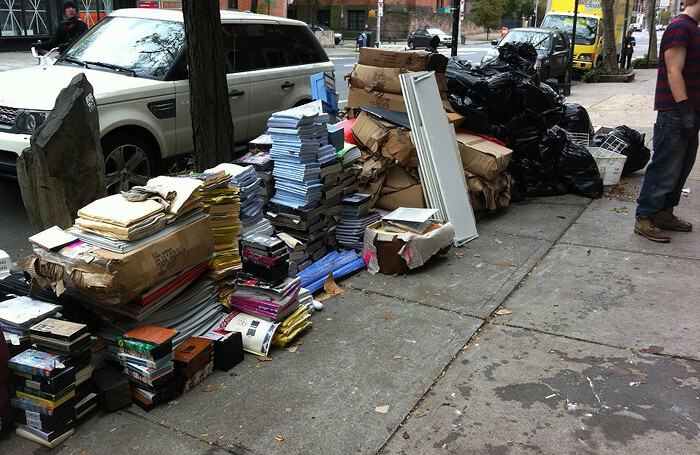Categories
Subjects
Authors
Artists
Venues
Locations
Calendar
Filter
Done
December 21, 2023 – Review
Andrea Bowers’s “Joy is an Act of Resistance”
R.H. Lossin

The first work that one encounters on entering Andrew Kreps’s gallery might be mistaken for an extension of the gallery’s commercial operations. Trans Bills (2023) consists of fifty-four black ring binders, arrayed on a shelf to the left of the front desk, labeled with the names of states that have passed legislation restricting the rights of trans citizens. The work’s blandness is perhaps the point. Quietly running in the background of clownish Republican performances of parental rights and viral videos of religious zealots is a legislative machine producing the reams of paper progressively restricting the rights of trans people to work, receive medical care, and live basic social lives. In a mere two years, 1,006 anti-trans bills have been introduced by state legislatures. An additional sixty-three have been introduced at the federal level.
At the back of the first-floor gallery is a 47-minute single-channel video of a trans prom organized by four teenagers as both an adolescent rite of passage and a protest—two things that are, for many trans youth, inseparable. The footage is visible from the gallery’s entrance, and the contrast between the young faces and the scale of adult animosity ranged against them is the show’s most valuable …
February 10, 2017 – Review
Halil Altindere’s “Space Refugee”
Orit Gat

Muhammed Ahmed Faris is the only Syrian who has traveled to outer space. A colonel in the Syrian Air Force, Faris—the subject of Turkish artist Halil Altindere’s video Space Refugee (2016)—joined the Soviet cosmonaut program in 1985 and was part of a mission to the Mir Space Station in 1987. “Those seven days 23 hours and five minutes changed my life,” Faris told The Guardian. He saw this experience as a privilege that he could share with other Syrians through education in science and astronomy, but that was not on the agenda of President Hafez al-Assad, who controlled Syria following a coup in 1970.
When in 2000 al-Assad died and his son Bashar succeeded him, Faris was the head of the Syrian Air Force Academy and a military advisor. To The Guardian, Faris describes both father and son as enemies of the people, who ruled by maintaining their population as uneducated and divided as possible. In 2011, when the revolution in Syria broke out, he marched in Damascus, calling for reform; the next year he defected to Turkey, becoming one of the five million Syrian refugees to leave the country.
Faris and Altindere met in Istanbul, and the cosmonaut became the subject …
November 14, 2012 – Feature
Chelsea after Sandy
Kareem Estefan

From houses scorched to the earth in Breezy Point, Queens, to homes completely swept away in Staten Island, when it came ashore late last month Hurricane Sandy wreaked unprecedented havoc on life as we know it in New York City. The storm cut off power for nearly a million New Yorkers, and tens of thousands remained without electricity, heat, or water for ten days or more. Artists, whose studios and galleries are disproportionately situated in coastal areas of Brooklyn and Manhattan like Red Hook, Dumbo, Greenpoint, Chelsea, the Lower East Side, and the East Village, have been among the hardest hit.
Two weeks after the storm, a besieged Chelsea art district is slowly coming to grips with the hurricane’s immense personal and economic impact, in artworks ruined and high-season sales foregone. To put a figure on the losses is, for now, a futile exercise. The neighborhood’s largest art insurance company, AXA, has received $40 million in claims from its clients, but many galleries were not insured by AXA—or at all—and even among those that were, the above sum does not even include equipment and infrastructure damage. If there is good news for the area west of Tenth Avenue, between 19th and …
December 7, 2011 – Review
Andrea Bowers’s "The New Woman’s Survival Guide"
Alan Gilbert
If one of the critiques—made by writers such as Audre Lorde and bell hooks—directed against early second-wave feminism was that it focused primarily on the concerns of white, middle-class, heterosexual women, more recent protest cultures have been criticized for fracturing into a plethora of identities and subject positions that resist being subsumed within larger social movements. The anti-globalization protests of the late 1990s and early 2000s may have been the pinnacle of this organizational mode. Occupy Wall Street, in turn, has shifted the focus more exclusively to economic questions, and in doing so has, like second-wave feminism, been accused of neglecting issues of ethnicity and sexual orientation, as well as, albeit to a lesser extent, gender.
Andrea Bowers’s second solo exhibition at Andrew Kreps adroitly touches on a wide range of these topics and histories. Part of what makes this possible is that Bowers has structured the show as an archive of past and present feminisms (all works are from 2011). The exhibition centers on an independently produced 1973 manual for everyday living entitled The New Woman’s Survival Catalog: A Woman-made Book, which was the result of firsthand research and reporting compiled from around the United States. It presented practical information …